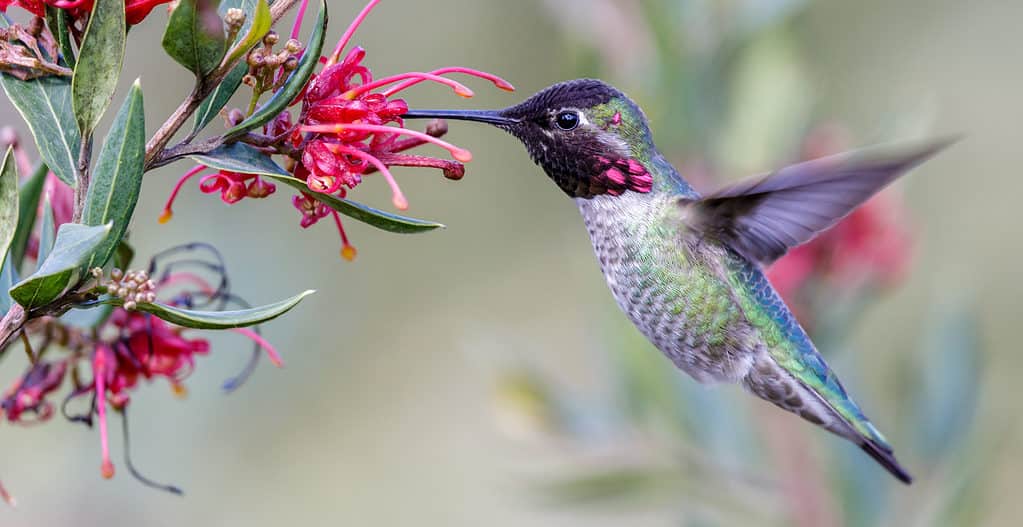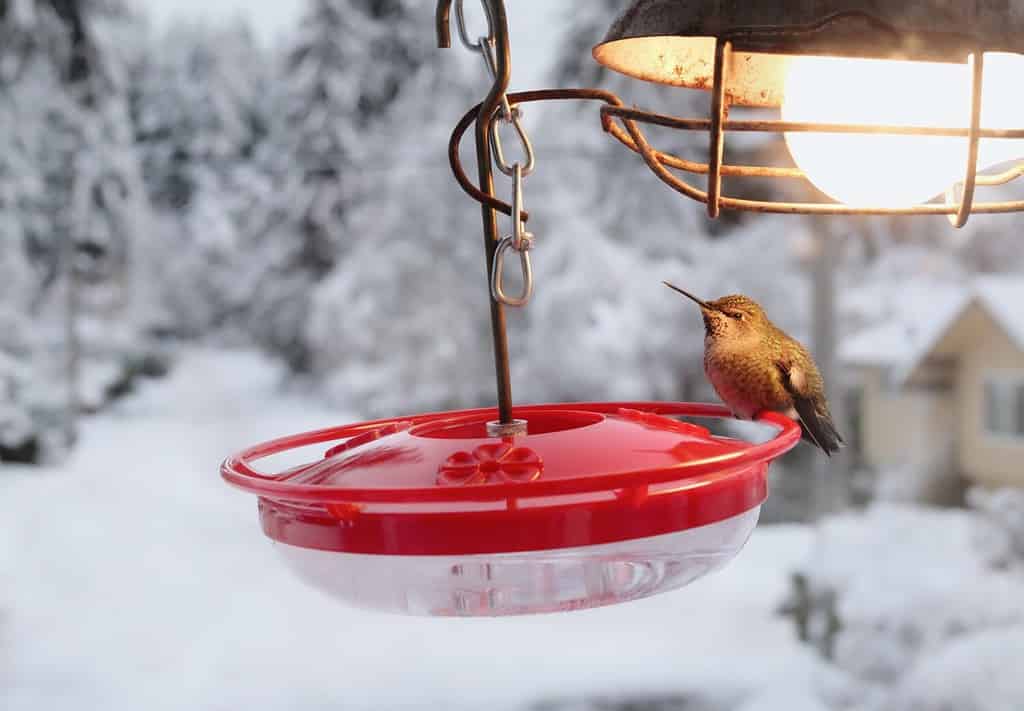When glimpsing a hummingbird, it’s easy to mistake it for an insect. They’re tiny and their wings beat rapidly like a dragonfly. This gives them the remarkable ability to hover over food sources, like little helicopters. They come in 366 species and are indigenous to almost all of North and South America, but some species are now endangered. Many people enjoy attracting these small birds with strategic landscaping or hummingbird feeders. Enthusiasts may worry about what will happen to hummingbirds during a cold snap. In this article, we share the coldest temperature a hummingbird can withstand and what you can do to help them survive the winter.
The Buzz on Hummingbirds

Hummingbirds are among the most brilliantly hued of all birds.
©Ondrej Prosicky/Shutterstock.com
We could go on forever about the fascinating characteristics of these tiny birds, but here are some of the essentials:
- Hummingbirds are the smallest birds in the world, ranging from the 2-inch bee hummingbird to the 9-inch giant hummingbird.
- They come in a wide variety of colors, including blue, green, and purple.
- The male is more colorful than the female, helping her stay more camouflaged with her eggs, and allowing him to put on a more impressive courtship display.
- They use their long beaks to eat nectar and small insects.
- Their wings flap from 12-80 beats per second, making a humming sound.
- At night they go into torpor, a state of reduced metabolism, to conserve energy.
- Some hummingbirds migrate long distances to the south in winter, while others stay put.
- One of the lowest temperatures ever recorded that a hummingbird survived was -8°F with a wind chill of -36°F!
How Low Can the Temperature Go?
Believe it or not, some species of hummingbirds survive cold weather quite well. They can survive even in subzero temperatures. One of the lowest temperatures ever recorded that a hummingbird successfully survived took place in 2014 in Pennsylvania when a banded rufous hummingbird survived nighttime lows of -8°F and wind chills of -36°F! Of course, this doesn’t apply to all species. Migratory species that need warmer weather to survive can die in an unseasonable cold snap that drops temperatures to freezing or below for several days.
Winter Survival Strategies for Hummingbirds
For North American hummingbirds, by far the most frequent winter survival strategy is migration. Their breeding grounds range from Canada to the coast of the Gulf of Mexico, but they typically migrate to Mexico and Central America. They start migrating south in late summer and early fall and return to the Gulf Coast by late February or March and back to the northern states by mid-May.
Migration for these tiny birds isn’t just a matter of moving brief distances from one flower to another until they get there. The ruby-throated hummingbird flies 500 miles nonstop over the Gulf of Mexico in just one day. This, from a bird 3.5 inches tall and weighing only 11 ounces! Other hummingbirds migrate 3,000 miles over the course of one to two weeks.
Overwintering

Anna’s hummingbirds survive cold temperatures due to their high body temperature and state of torpor.
©yhelfman/Shutterstock.com
Not all species migrate. Some in the milder climates of the southeastern and southwestern United States stay put for the winter. A species known as Anna’s hummingbird winters in Washington State and British Columbia. With a heartbeat of 600 beats a minute, it maintains an internal temperature of 107 °F to keep itself toasty while going about its daily business. Another strategy they use is to fluff their feathers to trap warm air around their bodies.
At night or on days that are especially cold or rainy, they go into a semi-hibernation state called torpor. Their heart rate slows, their body heat drops by as much as 50 °F, and their breathing can even stop momentarily. It can take up to an hour to emerge from torpor. The hummingbird shivers to warm itself up and get back to full functionality.
What Can You Do to Help Hummingbirds in Winter?
What Do Hummingbirds Eat in Winter?
If you live in a place where some hummingbird species overwinter rather than migrate, rest assured they are able to take care of their own needs without help. You might wonder how they can eat if no nectar is available. Overwintering species eat insects and sap during the winter to take care of their nutritional needs.
Will Feeding Hummingbirds Interfere with Migration?
If you have been feeding non-migratory hummingbirds, you should continue to put out your feeders in the winter but take care that they don’t freeze. There is no need to worry this would prevent migratory species from moving on, as their migration instinct and the dropping temperatures are enough to move them along on their journey regardless of how much sugar water you put out for them. But once you start feeding in the winter you need to keep on doing it consistently until warm weather returns. Creating a scenario in which hummingbirds depend on you for food can mean starvation if you forget about them.
Maintaining Hummingbird Feeders in Winter

A shop light over your feeder can keep hummingbird food from freezing in winter.
©sophiecat/Shutterstock.com
Here are a few things to keep in mind when feeding hummingbirds for the winter:
- Change the food in your feeders regularly. You can make hummingbird nectar with sugar and water at a ratio of 1:4 sugar to water.
- Clean your feeders frequently.
- Put your feeders in places that are sheltered from cold wind and snow.
- Bring your feeders in at night to keep them from freezing or use a feeder warmer.
- Use more than one feeder and rotate them on cold days to prevent them from freezing.
- Place hand warmers, holiday lights, or a shop or work light near your feeder to keep it warm.
- Protect your feeders from frost with bubble wrap, cloth, or foam.
Being mindful of your hummingbird friends’ needs during the winter, feeding them consistently, and keeping your feeders well-maintained will make you a good neighbor to these adorable little helicopters of nature.
The photo featured at the top of this post is © Chelsea Sampson/Shutterstock.com
Thank you for reading! Have some feedback for us? Contact the AZ Animals editorial team.







